Joual is an accepted name for the linguistic features of Quebec French that are associated with the French-speaking working class in Montreal which has become a symbol of national identity for some. Joual has historically been stigmatized by some, and celebrated by others. While Joual is often considered a sociolect of the Québécois working class, many feel that perception is outdated, with Joual becoming increasingly present in the arts.
Quebec French, also known as Québécois French, is the predominant variety of the French language spoken in Canada. It is the dominant language of the province of Quebec, used in everyday communication, in education, the media, and government.
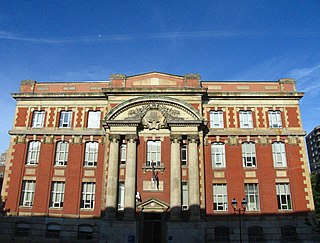
The Office québécois de la langue française is a public organization established on 24 March 1961, by the Liberal government of Jean Lesage. Attached to the Ministère de la Culture et des Communications du Québec, its initial mission, defined in its report of 1 April 1964, was "to align on international French, promote good Canadianisms and fight Anglicisms ... work on the normalization of the language in Quebec and support State intervention to carry out a global language policy that would consider notably the importance of socio-economic motivations in making French the priority language in Quebec".
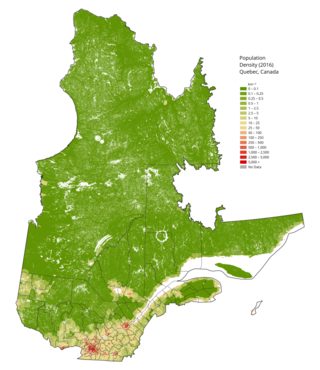
The demographics of Quebec constitutes a complex and sensitive issue, especially as it relates to the National question. Quebec is the only province in Canada to feature a francophone (French-speaking) majority, and where anglophones (English-speakers) constitute an officially recognized minority group. According to the 2011 census, French is spoken by more than 85.5% of the population while this number rises to 88% for children under 15 years old. According to the 2011 census, 95% of Quebec are able to conduct a conversation in French, with less than 5% of the population not able to speak French.
An anglicism is a word or construction borrowed from English by another language.
This article presents the current language demographics of the Canadian province of Quebec.
Francization or Francisation, Frenchification, or Gallicization is the expansion of French language use—either through willful adoption or coercion—by more and more social groups who had not before used the language as a common means of expression in daily life. As a linguistic concept, known usually as gallicization, it is the practice of modifying foreign words, names, and phrases to make them easier to spell, pronounce, or understand in French.
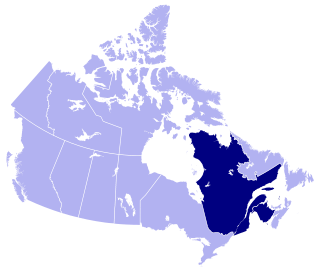
French is the mother tongue of approximately 7.2 million Canadians according to the 2016 Canadian Census. Most Canadian native speakers of French live in Quebec, the only province where French is the majority language and the only province in which it is the sole official language. Of Quebec's people, 71.2 percent are native francophones and 95 percent speak French as their first or second language.
The Commission of Inquiry on the Situation of the French Language and Linguistic Rights in Quebec was established under the Union Nationale government of Jean-Jacques Bertrand on December 9, 1968.

Varieties of the French language are spoken in France and around the world. The Francophones of France generally use Metropolitan French although some also use regional dialects or varieties such as Meridional French. In Europe outside France there are Belgian French, Swiss French, and in Italy Aostan French. In Canada, French is an official language along with English; the two main dialects of French in Canada are Quebec French and Acadian French. Standard French is also commonly grouped as Canadian French. In Lebanon, French was an official language until 1941 and the main dialect spoken there is Lebanese French or Levantine French. Levantine French was also spoken by Sephardic Jews in Salonica, Istanbul and Smyrna, by Armenians and Greek bourgeois in the urban centres of Asia Minor, by Syrian Catholics and Melkites in Aleppo and Beirut.
Canadian French is the French language as it is spoken in Canada. It includes multiple varieties, the most prominent of which is Québécois. Formerly Canadian French referred solely to Quebec French and the closely related varieties of Ontario (Franco-Ontarian) and Western Canada—in contrast with Acadian French, which is spoken by Acadians in New Brunswick and some areas of Nova Scotia, Prince Edward Island and Newfoundland & Labrador.

Henri Wittmann is a Canadian linguist from Quebec. He is best known for his work on Quebec French.
Magoua, which may derive from a word in Atikamekw: Makwa French: huard) which means loon, is a particular dialect of basilectal Quebec French spoken in the Trois-Rivières area, between Trois-Rivières and Maskinongé. Long before a military fort was constructed there, Trois-Rivières became in 1615 the first stronghold of the coureurs des bois outside the city of Québec. Magoua is the ethnonym applied to their descendants in the area. Magoua is the most conservative of all Quebec French varieties, including Joual. It preserves the sontaient ("étaient") characteristic of Métis French and Cajun French, has a creole-like past tense particle tà and has old present-tense contraction of a former verb "to be" that behave in the same manner as subject clitics.
Métis French, along with Michif and Bungi, is one of the traditional languages of the Métis people, and the French-dialect source of Michif.
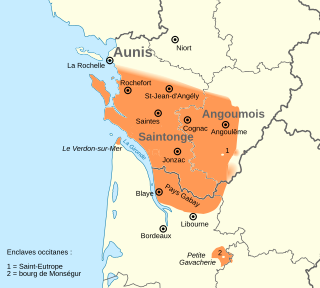
Saintongeais (saintonjhais) is a dialect of Poitevin-Santongeais spoken halfway down the western coast of France in the former provinces of Saintonge, Aunis and Angoumois, all of which have been incorporated into the current departments of Charente and Charente-Maritime as well as in parts of the neighbouring department of Gironde and a town in Dordogne. Although many of the same words are used in both Charente departments, they differ in what they mean or in how they are pronounced.
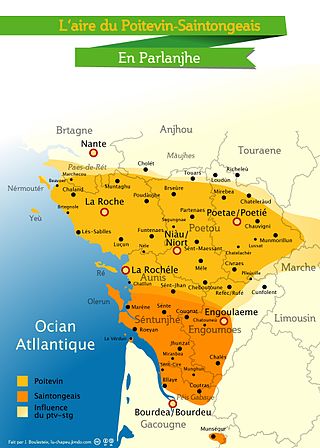
Poitevin (poetevin) is a dialect of Poitevin-Saintongeais, one of the regional languages of France, spoken in the historical province of Poitou, now administratively divided between Pays de la Loire and Nouvelle-Aquitaine. It is not as commonly spoken as it once was, as the standard form of French now predominates. Poitevin is now classified as one of the langues d'oïl but is distinguished by certain features adopted from Occitan.

The official language of the Republic of Congo is French. Other languages are mainly Bantu languages, and the two national languages in the country are Kituba and Lingala, followed by Kongo languages, Téké languages, and more than forty other languages, including languages spoken by Pygmies, which are not Bantu languages.
The First Congress on the French Language in Canada was held in Quebec City from June 24 to June 30, 1912. Its stated objective was to "examine the questions raised by the defence, the culture and the development of the French language and literature in Canada."
Geneviève Massignon was a French linguist, ethnologist, musicologist and historian who studied Acadian speech, as well as dialects and linguistic communities in Brittany, in the west of France and in Corsica. She published several important works based on this research.
Jean-Claude Corbeil, was a Canadian linguist and lexicographer. He served as head of the linguistic department at the Office québécois de la langue française from 1971 to 1977 and oversaw the introduction of Quebec's language laws during that decade. He also co-authored several visual dictionaries for Scholastic Corporation, Macmillan Publishers, Firefly Learning, and Merriam-Webster.







